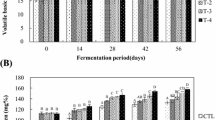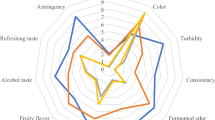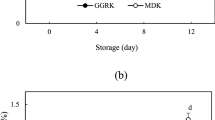Abstract
The effects of supplementing kimchi with acetic acid (TSA)- and citric acid (TSC)-treated skate were investigated during the fermentation process. The chemical and microbiological properties of the product were also investigated. The quality parameters of kimchi were determined by measuring the pH, titratable acidity, reducing sugar content, volatile basic nitrogen (VBN), biogenic amines (BAs), and microbial analysis. During fermentation, the kimchi containing skate was observed to have a lower acidity than the control. Treatment of skate with an organic acid increased the acidity and gradually decreased the reducing sugar content during fermentation. Higher concentrations of organic acid resulted in a decrease in VBN and BAs in the TSA and TSC groups compared to those in the kimchi containing skate. The results suggest that supplementing kimchi with skate treated with organic acids affects the histamine content of the products.
Similar content being viewed by others
References
Bae MS, Lee SC. Preparation and characteristics of kimchi with added Styela clava. Korean J. Food Cook. Sci. 24: 573–579 (2008)
Kim KH, Cho HS. Physicochemical and microbiological properties of skate (Raja kenojei) kimchi on the market. J. Korean Soc. Food Cult. 23: 235–242 (2008)
Ryu BM, Jeon YS, Song YS, Moon GS. Physicochemical and sensory characteristics of anchovy added kimchi. J. Korean Soc. Food Sci. Nutr. 25: 460–469 (1996)
Ku HS, Noh JS, Yoon YR, Kim HJ, Kwon MJ, Cheigh HS, Song YO. Weight reduction and lipid lowering effects of sea tangle added Korean cabbage kimchi. J. Korean Soc. Food Sci. Nutr. 36: 1140–1147 (2007)
Jang MS, Park HY, Park JI, Byun HS, Kim YK, Yoon HD. Analysis of nutrient composition of Baechu kimchi (Chinese cabbage kimchi) with seafoods. Korean J. Food Preserv. 18: 535–545 (2011)
Lee MA, Seo HY, Yang JH, Jang MS. Effect of squid and octopus on the quality characteristics of kimchi during fermentation. J. Korean Soc. Food Sci. Nutr. 42: 2004–2011 (2013)
Woo MJ, Choi JR, Kim MJ, Jang MS, Cho EJ, Song YO. Physicochemical characteristics of seafood added kimchi during fermentation and its sensory properties. J. Korean Soc. Food Sci. Nutr. 41: 1771–1777 (2012)
Lee YK, Lee MY, Kim SD. Effects of monosodium glutamate and temperature change on the content of free amino acids in kimchi. J. Korean Soc. Food Sci. Nutr. 33: 399–404 (2004)
Kim EM, Kim YM, Jo JH, Woo SJ. A study on the housewives recognition and preference of seafoods and fermented seafoods add kimchi. J. Korean Soc. Food Cult. 13: 19–26 (1998)
Park SY, Lim HY, Park SG, Cho MJ. Quality and preference changes red sea cucumber (Stichopus japonicus) kimchi during storage period. Appl. Biol. Chem. 55: 135–140 (2012)
Smith CP, Wright PA. Molecular characterization of commercial slices of and elasmobranch urea transporter. Am. J. Physiol. 276: 622–626 (1999)
Lee EJ, Seo JE, Lee JK, Oh SW, Kim YJ. Microbial and chemical properties of ready-to-eat skate in Korean market. J. Food Hyg. Safety. 23: 137–141 (2008)
Huxtable RJ. Physiological actions of taurine. Physiol. Rev. 72: 101–163 (1992)
Lee KA. Extractive nitrogenous constituents of fermented commercial skate, Raja kenojei. MS Thesis, Yosu National University, Yosu, Korea (1999)
Lee ES, Kim YS, Ryu MS, Jeong DY, Uhm TB, Cho SH. Characterization of Bacillus licheniformis SCK A08 with antagonistic property against Bacillus cereus and degrading capacity of biogenic amines. J. Food Hyg. Safety 29: 40–46 (2014)
Shukla S, Park HK, Kim JK, Kim MH. Determination of biogenic amines in Japanese miso products. Food Sci. Biotechnol. 23: 851–854 (2011)
Miller GL. Use of dinitrosalicylic acid reagent for determination of reducing sugar. Anal. Chem. 31: 426–428 (1959)
AOAC. Official Method of Analysis of AOAC Intl. 16th ed. Association of Official Analytical Chemists, Arlington, VA, USA (1995)
Lee HT, Kim JH, Lee SS. Analysis of microbiological and biogenic amines content in traditional and commercial doenjang. J. Food Hyg. Safety 24: 102–109 (2009)
Lee HM, Lee YA. A differential medium for lactic acid-producing bacteria in a mixed culture. Lett. Appl. Microbiol. 46: 676–681 (2008)
Duncan DB. Multiple-range and multiple F tests. Biometrics 11: 1–42 (1955)
Kim YS, Shin DW. Hygienic superiority of kimchi. J. Food Hyg. Safety 23: 91–97 (2008)
Kim HJ, Eo JH, Kim SJ, Eun HB. Physicochemical changes in fermented skate (Raja Kenokei) treated with organic acids during storage. Korean J. Food Sci. Technol. 42: 438–444 (2010)
Park SK, Cho YS, Park JR, Moon JS, Lee YS. Changes in the contents of sugar, organic acid, free amino acid and nucleic acid related compounds during fermentation of mustard leaf kimchi. J. Korean Soc. Food Nutr. 24: 48–53 (1995)
Moon SW, Lee MK. Effects of added harvey powder on the quality of Yulmoo kimchi. J. Korean Soc. Food Sci. Nutr. 40: 435–443 (2011)
Yi JH, Cho Y, Hwang IK. Fermentative characteristics of kimchi prepared by addition of different kinds of minor ingredients. Korean J. Food Cook. Sci. 14: 1–10 (1998)
Park SY. Food quality evaluation of raw and salted mackerel collected at market in Busan. MS thesis, Pukyoung National University, Busan, Korea (2009)
Chae SK. Studies on microbial and enzymatic actions during the ripening process of salted Alaska Pollack tripe. Korean J. Food Nutr. 24: 340–349 (2011)
Lee JR, Jung JD, Lee JI, Song YM, Jin SK, Kim IS, Kim HY, Lee JH. The effects of emulsion-type sausages containing mulberry leaf and persimmon leaf powder on lipid oxidation, nitrite, VBN and fatty acid composition. Korean J. Food Sci. Ani. Resour. 23: 1–8 (2003)
Bilgin B, Genccelep H. Determination of biogenic amines in fish products. Food Sci. Biotechnol. 24: 1907–1913 (2015)
Moon JS, Kim J, Jang KI, Cho KJ, Yang SJ, Yoon GM, Kim SY, Han NS. Analysis of biogenic amines in fermented fish products consumed in Korea. Food Sci. Biotechnol. 19: 1689–1692 (2010)
Alvarez MA, Moreno-Arribas MV. The problem of biogenic amines in fermented foods and the use of potential biogenic amine-degrading microorganisms as a solution. Trends Food Sci. Tech. 39: 146–155 (2014)
Kim MJ, Kim KS. Tyramine production among lactic acid bacteria and other species isolated from kimchi. LWT-Food Sci. Technol. 56: 406–413 (2014)
Jeong DW, Lee JH. Antibiotic resistance, hemolysis and biogenic amine production assessments of Leuconostoc and Weissella isolates for kimchi starter development. LWT-Food Sci. Technol. 64: 1078–1084 (2015)
Chu CH, Bjeldanes LF. Effects of diamines, polyamines and tuna fish extracts on the binding of histamine to mucin in vitro. J. Food Sci, 47: 7980–7988 (1981)
Kang HW. Characteristics of kimchi added with anchovy sauce from heat and non-heat treatments. Korean J. Culinary Res. 19: 49–58 (2013)
Lee KE, Lee YH. Effect of Lactobacillus plantarum as a starter on the food quality and microbiota of kimchi. Food Sci. Biotechnol. 19: 641–646 (2010)
Moon SW, Jang MS. Effects of Omija (Schizandra chinensis Baillon) on the sensory and microbiological properties of Nabak kimchi during fermentation. J. Korean Soc. Food Sci. Nutr. 29: 822–831 (2000)
Author information
Authors and Affiliations
Corresponding author
Rights and permissions
About this article
Cite this article
Choi, YJ., Jang, MS. & Lee, MA. Physicochemical changes in kimchi containing skate (Raja kenojei) pretreated with organic acids during fermentation. Food Sci Biotechnol 25, 1369–1377 (2016). https://doi.org/10.1007/s10068-016-0214-4
Received:
Revised:
Accepted:
Published:
Issue Date:
DOI: https://doi.org/10.1007/s10068-016-0214-4




